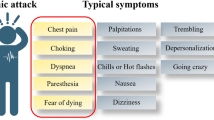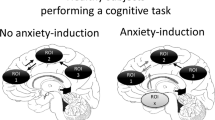Abstract
Panic disorder (PD) is a subtype of anxiety disorder in which the core phenomenon is the spontaneous occurrence of panic attacks. Although studies with laboratory animals have been instrumental for the understanding of its neurobiology and treatment, few review articles have focused on the validity of the currently used animal models for studying this psychopathology. Therefore, the aim of the present paper is to discuss the strengths and limits of these models in terms of face, construct and predictive validity. Based on the hypothesis that panic attacks are related to defensive responses elicited by proximal threat, most animal models measure the escape responses induced by specific stimuli. Some apply electrical or chemical stimulation to brain regions proposed to modulate fear and panic responses, such as the dorsal periaqueductal grey or the medial hypothalamus. Other models focus on the behavioural consequences caused by the exposure of rodents to ultrasound or natural predators. Finally, the elevated T-maze associates a one-way escape response from an open arm with panic attacks. Despite some limitations, animal models are essential for a better understanding of the neurobiology and pharmacology of PD and for discovering more effective treatments.
Similar content being viewed by others
References
Amano K, Tanikawa T, Iseki H, Kawabatake H, Notani M, Kawamura H, Kitamura K (1978) Single neuron analysis of the human midbrain tegmentum. Rostral mecencephalic reticulotomy for pain relief. Appl Neuropsychol 41:66–78
Bandler R, Keay KA, Floyd N, Price J (2000) Central circuits mediating patterned autonomic activity during active vs. passive emotional coping. Brain Res Bull 53:95–104
Bard P (1928) A diencephalic mechanism for the expression of rage with special reference to the sympathetic nervous system. Am J Physiol 84:490–515
Beckett S, Marsden CA (1995) Computer analysis and quantification of periaqueductal grey-induced defence behaviour. J Neurosci Methods 58:157–161
Beckett SR, Aspley S, Graham M, Marsden CA (1996) Pharmacological manipulation of ultrasound induced defence behaviour in the rat. Psychopharmacology (Berl) 127:384–390
Blanchard DC, Blanchard RJ (1988) Ethoexperimental approaches to the biology of emotion. Annu Rev Psychol 39:43–68
Blanchard DC, Griebel G, Blanchard RJ (2001) Mouse defensive behaviors: pharmacological and behavioral assays for anxiety and panic. Neurosci Biobehav Rev 25:205–218
Blanchard DC, Griebel G, Blanchard RJ (2003) The mouse defense test battery: pharmacological and behavioral assays for anxiety and panic. Eur J Pharmacol 463:97–116
Brandão ML, Borelli KG, Nobre MJ, Santos JM, Albrechet-Souza L, Oliveira AR, Martinez RC (2005) GABAergic regulation of the neural organization of fear in the midbrain tectum. Neurosci Biobehav Rev 29:1299–1311
Canteras NS (2002) The medial hypothalamic defensive system: hodological organization and functional implications. Pharmacol Biochem Behav 71:481–491
Carobrez AP, Teixeira KV, Graeff FG (2001) Modulation of defensive behavior by periaqueductal gray NMDA/glycine-B receptor. Neurosci Biobehav Rev 25:697–709
Darwin C (1872) The expression of emotions in man and animals. Harper Collins, London
de Bortoli VC, Nogueira RL, Zangrossi H Jr (2006) Effects of fluoxetine and buspirone on the panicolytic-like response induced by the activation of 5-HT1A and 5-HT2A receptors in the rat dorsal periaqueductal gray. Psychopharmacology (Berl) 183:422–428
Deakin JF, Graeff FG (1991) 5-HT and mechanisms of defence. J Psychopharmacol 5:305–315
DiMicco JA, Samuels BC, Zaretskaia MV, Zaretsky DV (2002) The dorsomedial hypothalamus and the response to stress: part renaissance, part revolution. Pharmacol Biochem Behav 71:469–480
Diniz L, dos Santos TB, Britto LR, Céspedes IC, Garcia MC, Spadari-Bratfisch RC, Medalha CC, de Castro GM, Montesano FT, Viana MB (2013) Effects of chronic treatment with corticosterone and imipramine on fos immunoreactivity and adult hippocampal neurogenesis. Behav Brain Res 238:170–177
DSM-IV-TR (2000) Diagnostic and statistical manual of mental disorders, text revision. APA, Washington
Feinstein JS, Buzza C, Hurlemann R, Follmer RL, Dahdaleh NS, Coryell WH, Welsh MJ, Tranel D, Wemmie JA (2013) Fear and panic in humans with bilateral amygdala damage. Nat Neurosci 16:270–272
Fernandez De Molina A, Hunsperger RW (1962) Organization of the subcortical system governing defence and flight reactions in the cat. J Physiol (Lond) 160:200–213
Fogaça MV, Lisboa SF, Aguiar DC, Moreira FA, Gomes FV, Casarotto PC, Guimarães FS (2012) Fine-tuning of defensive behaviors in the dorsal periaqueductal gray by atypical neurotransmitters. Braz J Med Biol Res 45:357–365
Freire RC, Hallak JE, Crippa JA, Nardi AE (2011) New treatment options for panic disorder: clinical trials from 2000 to 2010. Expert Opin Pharmacother 12:1419–1428
Gorman JM, Fyer MR, Goetz R, Askanazi J, Liebowitz MR, Fyer AJ, Kinney J, Klein DF (1988) Ventilatory physiology of patients with panic disorder. Arch Gen Psychiatry 45:31–39
Graeff FG, Del-Ben CM (2008) Neurobiology of panic disorder: from animal models to brain neuroimaging. Neurosci Biobehav Rev 32:1326–1335
Graeff FG, Zangrossi H (2002) Animal models of anxiety disorders. In: Westenberg H, Willner P, D’haenen JA (eds) Textbook of biological psychiatry. Wiley, London, pp 879–893
Graeff FG, Zangrossi H Jr (2010) The dual role of serotonin in defense and the mode of action of antidepressants on generalized anxiety and panic disorders. Cent Nerv Syst Agents Med Chem 10:207–217
Graeff FG, Viana MB, Tomaz C (1993) The elevated T maze, a new experimental model of anxiety and memory: effect of diazepam. Braz J Med Biol Res 2:67–70
Griebel G, Blanchard DC, Blanchard RJ (1996) Predator-elicited flight responses in Swiss-Webster mice: an experimental model of panic attacks. Prog Neuropsychopharmacol Biol Psychiatry 20:185–205
Hess WR (1943) Das subkortikale Zentrum der effektiven Abwehrreaktion. Helv Physiol Pharmacol Acta 1:33–52
Hogg S, Michan L, Jessa M (2006) Prediction of anti-panic properties of escitalopram in the dorsal periaqueductal grey model of panic anxiety. Neuropharmacology 51:141–145
Jacob CA, Cabral AH, Almeida LP, Magierek V, Ramos PL, Zanoveli JM, Landeira-Fernandez J, Zangrossi H, Nogueira RL (2002) Chronic imipramine enhances 5-HT(1A) and 5-HT(2) receptors-mediated inhibition of panic-like behavior in the rat dorsal periaqueductal gray. Pharmacol Biochem Behav 72:761–766
Jenck F, Broekkamp CL, Van Delft AM (1990) The effect of antidepressants on aversive periaqueductal gray stimulation in rats. Eur J Pharmacol 177:201–204
Jenck F, Moreau JL, Martin JR (1995) Dorsal periaqueductal gray-induced aversion as a simulation of panic anxiety: elements of face and predictive validity. Psychiatry Res 57:181–191
Johnson PL, Shekhar A (2012) An animal model of panic vulnerability with chronic disinhibition of the dorsomedial/perifornical hypothalamus. Physiol Behav 107:686–698
Johnson P, Lowry C, Truitt W, Shekhar A (2008a) Disruption of GABAergic tone in the dorsomedial hypothalamus attenuates responses in a subset of serotonergic neurons in the dorsal raphe nucleus following lactate-induced panic. J Psychopharmacol 22:642–652
Johnson PL, Truitt WA, Fitz SD, Lowry CA, Shekhar A (2008b) Neural pathways underlying lactate-induced panic. Neuropsychopharmacology 33:2093–2107
Johnson PL, Truitt W, Fitz SD, Minick PE, Dietrich A, Sanghani S, Träskman-Bendz L, Goddard AW, Brundin L, Shekhar A (2010) A key role for orexin in panic anxiety. Nat Med 16:111–115
Johnson PL, Fitz SD, Hollis JH, Moratalla R, Lightman SL, Shekhar A, Lowry CA (2011) Induction of c-Fos in “panic/defence”-related brain circuits following brief hypercarbic gas exposure. J Psychopharmacol 25:26–36
Kellner M (2011) Experimental panic provocation in healthy man—a translational role in anti-panic drug development? Dialogues Clin Neurosci 13:485–493
Kessler RC, Ruscio AM, Shear K, Wittchen HU (2010) Epidemiology of anxiety disorders. Curr Top Behav Neurosci 2:21–35
Klein S, Nicolas LB, Lopez-Lopez C, Jacobson LH, McArthur SG, Grundschober C, Prinssen EP (2010) Examining face and construct validity of a noninvasive model of panic disorder in Lister-hooded rats. Psychopharmacology (Berl) 211:197–208
McNaughton N, Corr PJ (2004) A two-dimensional neuropsychology of defense: fear/anxiety and defensive distance. Neurosci Biobehav Rev 28:285–305
Mobbs D, Petrovic P, Marchant JL, Hassabis D, Weiskopf N, Seymour B, Dolan RJ, Frith CD (2007) When fear is near: threat imminence elicits prefrontal-periaqueductal gray shifts in humans. Science 317:1079–1083
Mongeau R, Marsden CA (1997a) Effect of central and peripheral administrations of cholecystokinin-tetrapeptide on panic-like reactions induced by stimulation of the dorsal periaqueductal grey area in the rat. Biol Psychiatry 42:335–344
Mongeau R, Marsden CA (1997b) Effect of imipramine treatments on the 5-HT1A-receptor-mediated inhibition of panic-like behaviours in rats. Psychopharmacology (Berl) 131:321–328
Nashold BS Jr, Wilson WP, Slaughter DG (1969) Sensations evoked by stimulation in the midbrain of man. J Neurosurg 30:14–24
Nicolas LB, Klein S, Prinssen EP (2007) Defensive-like behaviors induced by ultrasound: further pharmacological characterization in Lister-hooded rats. Psychopharmacology (Berl) 194:243–252
Pinheiro SH, Zangrossi H Jr, Del-Ben CM, Graeff FG (2007) Elevated mazes as animal models of anxiety: effects of serotonergic agents. An Acad Bras Cienc 79:71–85
Pinheiro SN, Del-Ben CM, Zangrossi H Jr, Graeff FG (2008) Anxiolytic and panicolytic effects of escitalopram in the elevated T-maze. J Psychopharmacol 22:132–137
Pobbe RL, Zangrossi H Jr, Blanchard DC, Blanchard RJ (2011) Involvement of dorsal raphe nucleus and dorsal periaqueductal gray 5-HT receptors in the modulation of mouse defensive behaviors. Eur Neuropsychopharmacol 21:306–315
Poltronieri SC, Zangrossi H Jr, de Barros Viana M (2003) Antipanic-like effect of serotonin reuptake inhibitors in the elevated T-maze. Behav Brain Res 147:185–192
Preter M, Klein DF (2008) Panic, suffocation false alarms, separation anxiety and endogenous opioids. Prog Neuropsychopharmacol Biol Psychiatry 32:603–612
Pulga A, Ruzza C, Rizzi A, Guerrini R, Calo G (2012) Anxiolytic- and panicolytic-like effects of neuropeptide S in the mouse elevated T-maze. Eur J Neurosci 36:3531–3537
Schenberg LC, Bittencourt AS, Sudre EC, Vargas LC (2001) Modeling panic attacks. Neurosci Biobehav Rev 25:647–659
Shekhar A (1994) Effects of treatment with imipramine and clonazepam on an animal model of panic disorder. Biol Psychiatry 36:748–758
Shekhar A, Keim SR (2000) LY354740, a potent group II metabotropic glutamate receptor agonist prevents lactate-induced panic-like response in panic-prone rats. Neuropharmacology 39:1139–1146
Shekhar A, Keim SR, Simon JR, McBride WJ (1996) Dorsomedial hypothalamic GABA dysfunction produces physiological arousal following sodium lactate infusions. Pharmacol Biochem Behav 55:249–256
Shuhama R, Del-Ben CM, Loureiro SR, Graeff FG (2007) Animal defense strategies and anxiety disorders. An Acad Bras Cienc 79:97–109
Silveira MC, Zangrossi H, de Barros Viana M, Silveira R, Graeff FG (2001) Differential expression of Fos protein in the rat brain induced by performance of avoidance or escape in the elevated T-maze. Behav Brain Res 126:13–21
Spiacci A Jr, Coimbra NC, Zangrossi H Jr (2012) Differential involvement of dorsal raphe subnuclei in the regulation of anxiety- and panic-related defensive behaviors. Neuroscience 227:350–360
Stein M, Steckler T, Lightfoot JD, Hay E, Goddard AW (2010) Pharmacologic treatment of panic disorder. Curr Top Behav Neurosci 2:469–485
Teixeira RC, Zangrossi H, Graeff FG (2000) Behavioral effects of acute and chronic imipramine in the elevated T-maze model of anxiety. Pharmacol Biochem Behav 65:571–576
Telch MJ, Rosenfield D, Lee HJ, Pai A (2012) Emotional reactivity to a single inhalation of 35% carbon dioxide and its association with later symptoms of posttraumatic stress disorder and anxiety in soldiers deployed to Iraq. Arch Gen Psychiatry 69:1161–1168
Vargas LC, Schenberg LC (2001) Long-term effects of clomipramine and fluoxetine on dorsal periaqueductal grey-evoked innate defensive behaviours of the rat. Psychopharmacology (Berl) 155:260–268
Wilent WB, Oh MY, Buetefisch CM, Bailes JE, Cantella D, Angle C, Whiting DM (2010) Induction of panic attack by stimulation of the ventromedial hypothalamus. J Neurosurg 112:1295–1298
Zangrossi H Jr, Graeff FG (1997) Behavioral validation of the elevated T-maze, a new animal model of anxiety.Brain Res Bull 44:1–5
Zanoveli JM, Netto CF, Guimarães FS, Zangrossi H Jr (2004) Systemic and intra-dorsal periaqueductal gray injections of cholecystokinin sulfated octapeptide (CCK-8 s) induce a panic-like response in rats submitted to the elevated T-maze. Peptides 25:1935–1941
Ziemann AE, Allen JE, Dahdaleh NS, Drebot II, Coryell MW, Wunsch AM, Lynch CM, Faraci FM, Howard MA 3rd, Welsh MJ, Wemmie JA (2009) The amygdala is a chemosensor that detects carbon dioxide and acidosis to elicit fear behavior. Cell 139:1012–1021
Author information
Authors and Affiliations
Corresponding author
Additional information
The authors gratefully acknowledge financial support from CNPq and FAPEMIG/APQ-01038-11 (F.A.M.), CNPQ and FAPESP (H.Z.J.), CNPQ and FAEPA (F.G.G.).
Rights and permissions
About this article
Cite this article
Moreira, F.A., Gobira, P.H., Viana, T.G. et al. Modeling panic disorder in rodents. Cell Tissue Res 354, 119–125 (2013). https://doi.org/10.1007/s00441-013-1610-1
Received:
Accepted:
Published:
Issue Date:
DOI: https://doi.org/10.1007/s00441-013-1610-1




